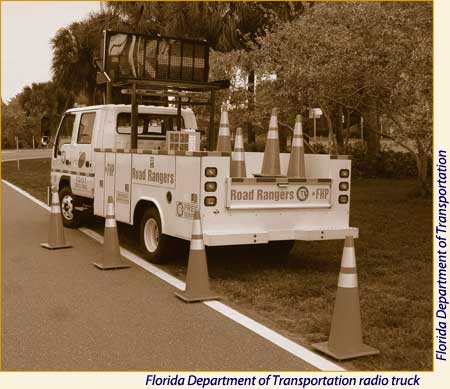Chapter 6. Glossary of Abbreviations and Terms
AADT – Annual Average Daily Traffic
AASHTO – American Association of State Highway and
Transportation Officials
ADOT – Arizona Department of Transportation
AED – Automated External Defibrillator
ATIS – Advanced Traveler Information Systems
AVL – Automatic Vehicle Location
Caltrans – California Department of Transportation
CapWIN – Capital Wireless Information Net
CCTV – Closed Circuit Television
CDL – Commercial Driver’s License
CDOT – Colorado Department of Transportation
CHP – California Highway Patrol
CMAQ – Congestion Mitigation and air Quality
Congestion Initiative – The National Strategy to
Reduce Congestion on America’s Transportation Network. Announced initiative and
plan by U.S. DOT to reverse trends of congestion.
ConOps – Concept of Operations. A formal document that
provides a user-oriented view of a proposed new system. (Source: IEEE Guide for
Information Technology-System)
DDOT – District Department of Transportation
DHS – Department of Homeland Security
DMS – Dynamic Message Sign also referred to as a
Variable Message Sign (VMS)
DOT – Department of Transportation
DOTD – Louisiana Department of Transportation and
Development
DPS – Arizona Department of Public Safety
DWI – Driving While Intoxicated
EMS – Emergency Medical Services
EMT – Emergency Medical Technician
EOC – Emergency Operations Center
ESF – Emergency Support Function
ETO – Emergency Transportation Operations
FDOT – Florida Department of Transportation
FFSP – Full-Function Service Patrol
FHP – Florida Highway Patrol
FHWA – Federal Highway Administration
FSP – Freeway Service Patrol
FTO – Field Traffic Officer
GDOT – Georgia Department of Transportation
GED – General Equivalency Diploma or General
Educational Development
GPS – Global Positioning System
HAZMAT – Hazardous Materials
HAZWOPER – Hazardous Waste Operations and Emergency
Response Standard
HOT – High Occupancy Toll
HOV – High Occupancy Vehicle
HSPD – Homeland Security Presidential Directive
IC – Incident Commander
ICS – Incident Command System
IDOT – Illinois Department of Transportation
IMAP – Incident Management Assistance Patrol
IR – Incident Response
IRU – Incident Response Unit
ITS – Intelligent Transportation Systems
ITS JPO – ITS Joint Program Office
KDOT – Kansas Department of Transportation
KHP – Kansas Highway Patrol
MAG – Maricopa Association of Governments
MAP – Motorist Assistance Program
MDOT – Michigan Department of Transportation
MDX – Miami-Dade Expressway Authority
MnDOT – Minnesota Department of Transportation
MoDOT – Missouri Department of Transportation
MOU – Memorandum of Understanding
MPO – Metropolitan Planning Organization
MUTCD – Manual on Uniform Traffic Control Devices
NCDOT – North Carolina Department of Transportation
NDOT – Nevada Department of Transportation
NFPA – National Fire Protection Agency
NHS – National Highway System
NHTSA – National Highway Traffic Safety
Administration
NIMS – National Incident Management System. “The National
Incident Management System provides a systematic, proactive approach guiding
departments and agencies at all levels of government, the private sector, and
nongovernmental organizations to work seamlessly to prepare for, prevent,
respond to, recover from, and mitigate the effects of incidents, regardless of
cause, size, location, or complexity, in order to reduce the loss of life,
property, and harm to the environment.” (Source: National Incident Management
System, FEMA 501, Draft August 2007)
NRF – National Response Framework
NTIMC – National Traffic Incident Management
Coalition
NTTA – North Texas Tollway Authority
NUG – National Unified Goal. Established by the
NTIMC, the NUG is: responder safety; safe, quick clearance; and prompt,
reliable, interoperable communications.
NYSDOT – New York State Department of Transportation
OSHA – Occupational Safety and Health Administration
ODOT – Oregon Department of Transportation
PennDOT – Pennsylvania Department of Transportation
PIO – Public Information Officer
PPP – Public-Private Partnership
RITA – Research and Innovative Technology Administration
ROP – Roadway Operations Patrol
RTMC – Regional Traffic Management Center
SANDAG – San Diego Association of Governments
SHSP – Strategic Highway Safety Plan
SLERS – State Law Enforcement Radio System
SOG – Standard Operating Guideline
SOP – Standard Operating Procedure
SPV – Service Patrol Vehicle
TCL – Target Capabilities List
TCT – Traffic Control Technician
TDOT – Tennessee Department of Transportation
TEMA – Tennessee Emergency Management Agency
 TIM – Traffic Incident Management. Defined as “the
systematic, planned, and coordinated use of human, institutional, mechanical,
and technical resources to reduce the duration and impact of incidents, and
improve the safety of motorists, crash victims, and incident responders.”
(Source: Traffic Incident Management Handbook)
TIM – Traffic Incident Management. Defined as “the
systematic, planned, and coordinated use of human, institutional, mechanical,
and technical resources to reduce the duration and impact of incidents, and
improve the safety of motorists, crash victims, and incident responders.”
(Source: Traffic Incident Management Handbook)
TIM Responder – Personnel responding to an incident
that mitigate its effects. May include personnel from law enforcement, fire
service, emergency medical services, HAZMAT, emergency management and public
works
TMC – Traffic Management Center, may also be known as
a Traffic Operations Center
Traffic Control Device – “All signs, signals, markings, and other devices used to
regulate, warn, or guide traffic placed on, over, or adjacent to a street,
highway, pedestrian facility, or bikeway by authority of a public agency having
jurisdiction.” (Source: MUTCD)
Traffic Incident – “An emergency road user
occurrence, a natural disaster, or other nonrecurring or unplanned event that
affects or impedes the normal flow of traffic” (Source: MUTCD); or “Non-recurring
event that causes a reduction of roadway capacity or an abnormal increase in
demand” (Source: Freeway Management and Operations Handbook)
TTC – Temporary Traffic Control. In the context of the
Service Patrol Handbook, TTC services are used in emergency or traffic incident
situations. TTC devices, equipment, and personnel are implemented in response
to an unplanned traffic incident. Typically includes resources that are “on-hand”
and readily available to TIM responders and the FFSP. Should not be confused
with TTC imposed in response to highway maintenance, highway work zones or
planned major events with longer durations.
TxDOT – Texas Department of Transportation
U.S. DOT – United States Department of Transportation
WSDOT – Washington State Department of Transportation
WisDOT – Wisconsin Department of Transportation
July 9, 2008
Publication #FHWA-HOP-08-031